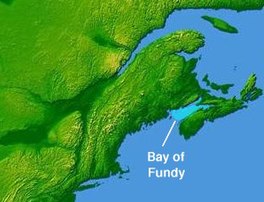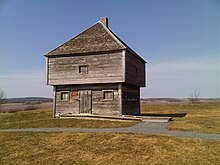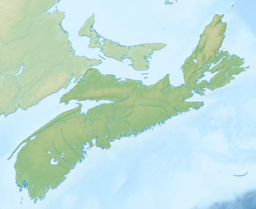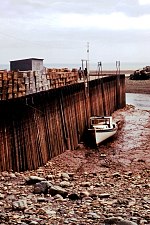Bay of Fundy
| Bay of Fundy | |
|---|---|
| Baie de Fundy | |
 The Bay of Fundy | |
| Location | New Brunswick,Nova Scotia,Maine |
| Coordinates | 45°00′N65°45′W/ 45.000°N 65.750°W |
| Type | Estuary |
| Etymology | Likely from the FrenchFendu,meaning "split". |
| Primary inflows | Canada and USA |
| River sources | Big Salmon,Magaguadavic,Memramcook,Petitcodiac,Quiddy,Saint John,St. Croix,Upper Salmon,Annapolis,Avon,Cornwallis,Farrells,Salmon,Shubenacadie,Kennetcook |
| Primary outflows | Gulf of Maine |
| Ocean/sea sources | Atlantic Ocean |
| References | |
TheBay of Fundy(French:Baie de Fundy) is a bay between theCanadian provincesofNew BrunswickandNova Scotia,with a small portion touching theU.S. stateofMaine.It is an arm of theGulf of Maine.Itstidal rangeis the highest in the world.[1]The name is probably a corruption of the French wordfendu,meaning 'split'.[2]
Hydrology[edit]
Tides[edit]
Thetidal rangein the Bay of Fundy is about 16 metres (52 ft); the average tidal range worldwide is only one metre (3.3 ft). Some tides are higher than others, depending on the position of the moon, the sun, and atmospheric conditions.[3]Tides are semidiurnal, meaning they have two highs and two lows each day,[3]with about six hours and 13 minutes between each high and low tide.[3]
Because oftidal resonancein the funnel-shaped bay, the tides that flow through the channel are very powerful. In one 12-hour tidal cycle, about 100 billion tonnes (110 billion short tons) of water flows in and out of the bay, which is twice as much as the combined total flow of all the rivers of the world over the same period.[4]TheAnnapolis Royal Generating Station,a 20MWtidal powerstation on theAnnapolis Riverupstream ofAnnapolis Royal,was, until its shutdown in 2019,[5]one of the few tidal generating stations in the world, and the only one in North America.[6]
Most of the rivers that drain into the Bay of Fundy have atidal bore,a wave front of the incoming tide that "bores" its way up a river against its normal flow. Notable tidal bores include those on thePetitcodiac,Maccan,St. Croix,andKennetcookrivers.[7]Before the construction of acausewayin 1968 and subsequentsiltationof the river, thePetitcodiac Riverhad one of the world's largest tidal bores, up to two metres (6.6 ft) high. Since the opening of the causeway gates in 2010, the bore has been coming back, and in 2013 surfers rode it a record-breaking 29 kilometres (18 mi).[8]
Other tidal phenomena include theReversing Fallsnear the mouth of theSaint John River,arip tideatCape Enrage,and theOld Sow whirlpoolatPassamaquoddy Bay.[7]
Geology[edit]
The story of theFundy Basinbegins about 200 million years ago in the earlyJurassic,when all land on earth was part of asupercontinentcalledPangaea.At that time what is nowthe Maritimeswas situated near theequatorand had a warmtropicalclimate and lush vegetation.[9]As continental drift reshaped the world,rift valleysformed, including theCobequid–Chedabuctofault system.
During the continental breakup,magmaerupted asbasalticlavasand leftigneous rockformations such as thecolumnar jointingwhich can be seen onBrierandGrand Mananislands, among other places around the bay. These flows often are the sites of rarer mineral deposits includingagate,amethyst,andstilbite,the latter being the provincial mineral of Nova Scotia.[9]
These rifts filled withsedimentwhich becamesedimentary rock.Many fossils have been found along the Fundy shoreline. The oldestdinosaurfossil in Canada was found atBurntcoat Head.Very earlyreptileshave been discovered inCarboniferoustree trunks atJoggins.Wasson Bluffhas a rich trove of Jurassic fossils.
The bay is a member of theGlobal Geoparks Network,[10]aUNESCOinitiative to promote and conserve the planet's geological heritage.
Flora and fauna[edit]
Although some land areas are protected, there is no formal marine protection zone in the bay.[11]The Conservation Council of New Brunswick works to protect the ecosystem of the bay.[12][13]A result of shipping traffic has been the potential for increased collisions between ships and the critically endangeredNorth Atlantic right whale.In 2003, theCanadian Coast Guardadjusted shipping lanes crossing prime whale feeding areas at the entrance to the Bay of Fundy to lessen the risk of collision. Many other marine mammals are found in the bay includingfin whales,humpback whales,minke whales,Atlantic white-sided dolphinand theharbour porpoise.
The Bay of Fundy mudflats are a rare and uniqueintertidalhabitat. Major mudflats are found on around the Maringouin Peninsula which lies betweenShepody Bayand theCumberland Basinand at the northern end ofChignecto Bay.On the Nova Scotia side, mudflats are found on the southern side of theMinas Basinand inCobequid Bay.In the Minas Basin, the size of the mudflats from low to high water marks is as much as 4 km (2.5 mi).[14]Due to tidal turbulence, the water in these area contains very high amounts of fine sediment, source from tidal erosion ofCarboniferousandTriassicsedimentary rock.Primary producersincludehollow green weed,phytoplankton,algae,andsea lettuce.
Protected areas include:
- Boot Island National Wildlife Area in the Minas Basin near the mouth of theGaspereau River.[15]
- Chignecto National Wildlife Area: near Amherst, contains a wide variety of habitats due to its geology.[16]
- Grindstone Island Conservation Easement: managed by the Nature Trust of New Brunswick through a conservation easement on an island at the entrance of Shepody Bay.[17]
- Isle Haute,managed by the Canadian Wildlife Service.[18]
- John Lusby Marsh National Wildlife Area: a large wetland system near Amherst.[19]
- Raven Head Wilderness Area, protects 44 km (27 mi) of undeveloped coast along the bay. It is southwest of Joggins and also a site for fossils. It is also a wildlife habitat for endangered species.[20]
- Shepody National Wildlife Area: a habitat for birds and other wildlife,[21]recognized as an important wetland under theRamsar Convention,a site of importance by theWestern Hemisphere Shorebird Reserve Network,and a bird area byBirdLife International.The dominant bird species is thesemipalmated sandpiper.
- South Wolf Island Nature Preserve: in the lower bay, about 12 km (7.5 mi) offshore fromBlacks Harbour.It was donated to the Nature Trust of New Brunswick byClover Leaf Seafoodsin 2011. It is ecologically important for birds, some not common on the mainland, as well as some very rare plants.[13]
- Tintamarre National Wildlife Area[22]
Human geography and history[edit]
History[edit]

TheMiꞌkmaqfished in the Bay of Fundy and lived in communities around the bay for centuries before the first Europeans arrived. According to Miꞌkmaq legend, the tide was created whenGlooscapwanted to take a bath.[23]
The first European to visit the bay may have been Portuguese explorerJoão Álvares Fagundesin about 1520, although the bay does not appear on Portuguese maps until 1558.[24]The first European settlement was French, founded atSaint Croix Islandin Maine, and thenPort Royal,founded byPierre DuguaandSamuel de Champlainin 1605. Champlain named itLabaye Francoise[25][26](The French Bay). Champlain describes finding an old rotted cross in the bay which may have been left by the Portuguese.[24]
The village was the first permanent European settlement north of the SpanishSt. Augustine, Florida,and predated by two years the first permanent British settlement inJamestown, Virginia.About 75 years later,Acadiansspread out along the bay, foundingGrand-Pré,Beaubassin,Cobequid,andPisiguit.[27]
There was much military action and many attacks on the settlements around the bay, first as the French and British fought for control of the area, leading to theexpulsion of the Acadians,and later by Americans during theAmerican Revolutionand theWar of 1812.[28]
In the 19th century, the bay was the site of much shipping, and shipbuilders flourished, includingJames MoranofSt. Martins, New Brunswick,Joseph Salter,ofMoncton,andWilliam D. LawrenceofMaitland, Nova Scotia.Fundy ports produced the fastest ship in the world,Marco Polo;the largest wooden ship ever built in Canada,William D. Lawrence;and the first female sea captain in the western world,Molly Kool.The mystery shipMary Celestewas also built there.
The highest water level ever recorded, 21.6 metres (71 feet), occurred in October 1869. It caused extensive destruction to ports and communities, much of which was attributed to a two-metrestorm surgecreated by theSaxby Gale,atropical cyclone,which coincided with aperigeanspringtide.Waves breached dykes protecting low-lying farmland in theMinas Basinand theTantramar Marshes,sending ocean waters surging far inland.
Settlements[edit]
The largest population centre on the bay isSaint John, New Brunswick,a major port and the first incorporated city in what is now Canada.[29][30]Other settlements include, in New Brunswick,St. Andrews,Blacks Harbour,Grand Manan,Campobello,Fundy-St. Martins,Alma,Riverside-Albert,Hopewell Cape,andSackville,and in Nova Scotia,Amherst,Advocate Harbour,Parrsboro,Truro,Maitland,Cheverie,Windsor,Wolfville,Canning,Annapolis Royal,andDigby.

Ports and shipping[edit]

The port of Saint John gives access to thepulp and paper industryand theIrvingoil refinery.Hantsport,Nova Scotia, also has a pulp and paper mill and shipsgypsumto the United States.
The bay is also traversed by ferries:
- Saint JohntoDigby,operated byBay Ferries.
- Grand ManantoBlacks HarbourandWhite Head Island,to Grand Manan, operated byCoastal Transport.
- The Letete toDeer IslandFerry, operated by theNew Brunswick Department of Transportation.
- Campobello Island,to Deer Island andEastport, Maine,to Deer Island. Operated by East Coast Ferries Limited.
- Brier IslandtoLong Islandand Long Island to peninsular Nova Scotia, operated by Nova Scotia Department of Transportation and Public Works.
Gallery[edit]
-
Tilted layers of sandstone at Hopewell Rocks
-
TheMinas Basinin early May
-
Reversing Fallsis where the Saint John River and Bay of Fundy meet.
-
Salmon River tidal bore
-
Basal contact of alava flowsection of Fundy basin
References[edit]
- ^National Ocean Service,
- ^Garrett, Chris; Koslow, Tony; Singh, Rabindra (March 25, 2015) [July 8, 2010]."Fundy, Bay of and Gulf of Maine".The Canadian Encyclopedia(online ed.).Historica Canada.
- ^abc"The Bay of Fundy is a 160 billion tonne wonder. Here's why".Tourism New Brunswick.Government of New Brunswick. 2018-05-02.Retrieved7 June2019.
- ^"Why are the Bay of Fundy Hides so High?".bayfundy.net.Retrieved15 June2019.
- ^Paul Withers."Nova Scotia Power to pull plug on tidal station, seeks $25M from ratepayers".CBC News.Retrieved26 June2023.
- ^"Annapolis Tidal Station".Nova Scotia Power.Archived fromthe originalon 1 July 2019.Retrieved1 July2019.
- ^ab"The tidal bore".Bay of Fundy.Retrieved15 June2019.
- ^"Surfers set record after 29 km ride on Moncton tidal bore".CBC.Retrieved18 June2019.
- ^abAtlantic Geoscience Society (2001).The Last Billion Years: a Geological History of the Maritime Provinces of Canada.Nimbus Pub. pp.126–134.ISBN1-55109-351-0.
- ^"UNESCO Global Geoparks – Cliffs of Fundy Aspiring Global Geopark – Tidal Landscapes on an Ancient Shoreline".Cliffs of Fundy aspiring Geopark.Retrieved15 June2019.
- ^"FAQ".Canadian Parks and Wilderness Society.Retrieved19 June2019.
- ^"Marine Conservation".Conservation Council of New Brunswick.2013-02-17. Archived fromthe originalon 2019-06-21.Retrieved21 June2019.
- ^ab"South Wolf Island Nature Preserve".Nature Trust of New Brunswick.Archived fromthe originalon 16 June 2020.Retrieved19 June2019.
- ^"Bay of Funday Mudflats".Fundy Biosphere.Archived fromthe originalon 29 September 2022.Retrieved20 June2019.
- ^"Boot Island National Wildlife Area".Government of Canada.2011-12-21.Retrieved20 June2019.
- ^"Chignecto National Wildlife Area".Government of Canada.2011-12-21.Retrieved20 June2019.
- ^"Grindstone Island Conservation Easement".Nature Trust of New Brunswick.Archived fromthe originalon 16 June 2020.Retrieved19 June2019.
- ^"Isle Haute National Wildlife Area".Government of Canada.23 April 2019.Retrieved19 June2019.
- ^"John Lusby Marsh National Wildlife Area".Government of Canada.2011-12-21.Retrieved20 June2019.
- ^"Raven Head Wilderness Area".Government of Nova Scotia.1 April 2009.Retrieved19 June2019.
- ^"Shepody National Wildlife Area".Government of Canada.2011-12-21.Retrieved20 June2019.
- ^"Tintamarre National Wildlife Area".Government of Canada.2011-12-21.Retrieved20 June2019.
- ^"Mi'kmaq Heritage".Bay of Fundy.1 February 2011.Retrieved15 June2019.
- ^ab"European Contact and Mapping".Mount Allison University. Archived fromthe originalon 24 June 2019.Retrieved23 July2019.
- ^Map of the northeast coast of North America, 1607, drawn by Samuel de Champlain,umaine.edu
- ^Champlain's 1607 Map of New England,old-maps
- ^Faragher, John Mack(2005).A Great and Noble Scheme: The Tragic Story of the Expulsion of the French Acadians from Their American Homeland.W.W Norton & Company. pp.110–112.ISBN978-0-393-05135-3.
- ^Smith, Joshua (2011).Battle for the Bay: The Naval War of 1812.Fredericton, NB: Goose Lane Editions. pp. passim.ISBN978-0-86492-644-9.
- ^"Port Saint John reports 2016 tonnage".Archived fromthe originalon July 28, 2017.RetrievedJuly 23,2017.
- ^"Saint John".Canadian Encyclopedia.RetrievedJune 12,2017.
See also[edit]
- Military action in the bay:Raid on St. John (1775),Battle off Cape Split,Raid on Annapolis Royal (1781).
- Fundy National Park,which connects to theFundy Footpath.
- The Rocks Provincial Park, site of theHopewell Rocks
- Cape Chignecto Provincial Park:Nova Scotia's largest provincial park, named forCape Chignecto,a headland which divides the Bay of Fundy andChignecto Bayto the north and the Minas Channel leading to theMinas Basinto the east.
- Blomidon Provincial Parkand Five Islands Provincial Park, both in Nova Scotia.
- Roosevelt Campobello International Park:preserves the house and surrounding landscape of the summer retreat ofFranklin D. Roosevelt,onCampobello Islandin New Brunswick.[1]
External links[edit]
- Where the Bay Becomes the Sea:a documentary about the Bay of Fundy ecosystem
- Bay of Fundy Ecosystem Partnership:scientific and popular information about the Bay.
- ^"Welcome to Campobello Island".VisitCampobello.Retrieved21 June2019.







